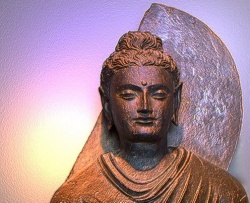Difference between revisions of "The Elaborator of Brief Statements"
(Created page with " <poem> The Buddha honored the Venerable Maha Kaccana by naming him his foremost disciple in the ability to provide detailed expositions of his own brief state...") |
|||
| (One intermediate revision by the same user not shown) | |||
| Line 1: | Line 1: | ||
| + | {{DisplayImages|60|912}} | ||
| + | |||
| + | |||
| + | |||
| + | |||
| + | |||
| + | |||
| + | |||
| + | |||
<poem> | <poem> | ||
| − | The [[Buddha]] honored the [[Venerable]] [[Maha Kaccana]] by naming him his foremost [[disciple]] in the ability to provide detailed expositions of his own brief statements. [[Maha Kaccana]] earned this distinguished title principally because of eight [[suttas]] found in the [[Nikayas]]: three in the [[Majjhima]], three in the [[Samyutta]], and two in the [[Anguttara]]. Besides these, we find in the [[Nikayas]] several other discourses that the [[Venerable]] [[Maha Kaccana]] spoke without basing himself upon a brief utterance of the [[Buddha]] as his text. All these discourses, taken together, have a {{Wiki|uniform}} and {{Wiki|distinctive}} flavor, revealing the qualities of the [[mind]] from which they sprang. They are thorough, balanced, careful and {{Wiki|cautious}}, substantial in content, meticulous in expression, incisive, well conceived, and well rounded. They are also, admittedly, a little dry — unemotional and unsentimental — but with no wastage of words they never fail to lead us straight to the [[heart]] of the [[Dhamma]]. | + | The [[Buddha]] honored the [[Venerable]] [[Maha Kaccana]] by naming him his foremost [[disciple]] in the ability to provide detailed [[expositions]] of his [[own]] brief statements. [[Maha Kaccana]] earned this {{Wiki|distinguished}} title principally because of eight [[suttas]] found in the [[Nikayas]]: three in the [[Majjhima]], three in the [[Samyutta]], and two in the [[Anguttara]]. Besides these, we find in the [[Nikayas]] several other [[discourses]] that the [[Venerable]] [[Maha Kaccana]] spoke without basing himself upon a brief utterance of the [[Buddha]] as his text. All these [[discourses]], taken together, have a {{Wiki|uniform}} and {{Wiki|distinctive}} {{Wiki|flavor}}, revealing the qualities of the [[mind]] from which they sprang. They are thorough, balanced, careful and {{Wiki|cautious}}, substantial in content, meticulous in expression, incisive, well [[conceived]], and well rounded. They are also, admittedly, a little dry — unemotional and unsentimental — but with no wastage of words they never fail to lead us straight to the [[heart]] of the [[Dhamma]]. |
| − | The discourses of [[Maha Kaccana]] are bare of the [[Wikipedia:Rhetoric|rhetorical]] devices utilized by other renowned exponents of the [[Dhamma]]: we find in them no similes, parables, or stories; their [[language]] is plain but impeccably precise. In this [[respect]] his sermons contrast with those of the [[Buddha]], the [[Venerable]] [[Sariputta]], and the [[Venerable]] [[Ananda]], all of whom were [[skilled]] in devising striking similes that impress the formal message of the {{Wiki|discourse}} indelibly on the auditor's [[mind]]. The [[Venerable]] [[Maha | + | The [[discourses]] of [[Maha Kaccana]] are bare of the [[Wikipedia:Rhetoric|rhetorical]] devices utilized by other renowned exponents of the [[Dhamma]]: we find in them no similes, [[parables]], or stories; their [[language]] is plain but impeccably precise. In this [[respect]] his [[sermons]] contrast with those of the [[Buddha]], the [[Venerable]] [[Sariputta]], and the [[Venerable]] [[Ananda]], all of whom were [[skilled]] in devising striking similes that impress the formal message of the {{Wiki|discourse}} indelibly on the auditor's [[mind]]. The [[Venerable]] [[Maha Kaccana's]] [[discourses]], it seems, owe their effectiveness entirely to their content and analytical exactitude rather than to {{Wiki|literary}} embellishment. |
| − | As an analyst of the [[Dhamma]], the [[Venerable]] [[Maha Kaccana]] most closely approximates to the [[Venerable]] [[Sariputta]], and indeed the discourses of both exhibit similar traits. The difference between them is principally a matter of emphasis rather than of [[substance]]. [[Sariputta's]] analytic disquisitions, as seen for example in the Sammaditthi [[Sutta]] and the | + | As an analyst of the [[Dhamma]], the [[Venerable]] [[Maha Kaccana]] most closely approximates to the [[Venerable]] [[Sariputta]], and indeed the [[discourses]] of both exhibit similar traits. The difference between them is principally a {{Wiki|matter}} of {{Wiki|emphasis}} rather than of [[substance]]. [[Sariputta's]] analytic disquisitions, as seen for example in the [[Sammaditthi]] [[Sutta]] and the [[Mahahatthipadopama Sutta]],[15] begin with a specified topic and then develop by dissecting that topic into its component [[strands]] and exploring each component in turn (often with still finer subdivisions). Within his [[own]] specialized [[sphere]] [[Maha Kaccana]] starts, not with a general topic, but with a short utterance of the [[Buddha]], often one that is intuitive, {{Wiki|poetic}}, or ex-hortatory in [[character]]. His [[exposition]] then unfolds by reformulating the gnomic or inspirational phrasing of the [[Buddha's]] statement in ways that link it up with established, more familiar frameworks of [[doctrine]], usually with the [[six spheres]] of [[sense]] and the practice of [[sense]] {{Wiki|restraint}}. Yet, despite their differences in {{Wiki|emphasis}}, both these great [[disciples]] share a predilection for systematic analysis and both display the same [[concern]] for razor-sharp precision in their [[thinking]]. |
| − | For this [[reason]], no [[doubt]], within the [[Theravada tradition]] each has come to be regarded as the father of a particular [[Wikipedia:scientific method|methodology]] for interpreting the [[Dhamma]], {{Wiki|exegetical}} systems that rose to prominence in the early centuries of [[Buddhist]] [[intellectual]] history. [[Sariputta]] is, of course, viewed as the original systematizer of the [[Abhidhamma]], which (according to [[tradition]]) he elaborated in detail based on the outlines that the [[Buddha]] taught him during his periodic visits to the [[human realm]] while expounding the [[Abhidhamma]] to the [[devas]] in the [[Tavatimsa heaven]].[16] [[Maha Kaccana]] is regarded as the author of a method of exposition embedded in two post-canonical works that exerted an important influence on the early [[Buddhist]] commentators. About these two works — the [[Petakopadesa]] and the Nettippakarana — we shall have more to say below. | + | For this [[reason]], no [[doubt]], within the [[Theravada tradition]] each has come to be regarded as the father of a particular [[Wikipedia:scientific method|methodology]] for interpreting the [[Dhamma]], {{Wiki|exegetical}} systems that rose to prominence in the early centuries of [[Buddhist]] [[intellectual]] history. [[Sariputta]] is, of course, viewed as the original systematizer of the [[Abhidhamma]], which (according to [[tradition]]) he elaborated in detail based on the outlines that the [[Buddha]] [[taught]] him during his periodic visits to the [[human realm]] while expounding the [[Abhidhamma]] to the [[devas]] in the [[Tavatimsa heaven]].[16] [[Maha Kaccana]] is regarded as the author of a method of [[exposition]] embedded in two post-canonical works that exerted an important influence on the early [[Buddhist]] commentators. About these two works — the [[Petakopadesa]] and the [[Nettippakarana]] — we shall have more to say below. |
</poem> | </poem> | ||
{{R}} | {{R}} | ||
[http://www.accesstoinsight.org/lib/authors/bodhi/wheel405.html www.accesstoinsight.org] | [http://www.accesstoinsight.org/lib/authors/bodhi/wheel405.html www.accesstoinsight.org] | ||
[[Category:Maha Kaccana]] | [[Category:Maha Kaccana]] | ||
Latest revision as of 21:57, 10 February 2024
The Buddha honored the Venerable Maha Kaccana by naming him his foremost disciple in the ability to provide detailed expositions of his own brief statements. Maha Kaccana earned this distinguished title principally because of eight suttas found in the Nikayas: three in the Majjhima, three in the Samyutta, and two in the Anguttara. Besides these, we find in the Nikayas several other discourses that the Venerable Maha Kaccana spoke without basing himself upon a brief utterance of the Buddha as his text. All these discourses, taken together, have a uniform and distinctive flavor, revealing the qualities of the mind from which they sprang. They are thorough, balanced, careful and cautious, substantial in content, meticulous in expression, incisive, well conceived, and well rounded. They are also, admittedly, a little dry — unemotional and unsentimental — but with no wastage of words they never fail to lead us straight to the heart of the Dhamma.
The discourses of Maha Kaccana are bare of the rhetorical devices utilized by other renowned exponents of the Dhamma: we find in them no similes, parables, or stories; their language is plain but impeccably precise. In this respect his sermons contrast with those of the Buddha, the Venerable Sariputta, and the Venerable Ananda, all of whom were skilled in devising striking similes that impress the formal message of the discourse indelibly on the auditor's mind. The Venerable Maha Kaccana's discourses, it seems, owe their effectiveness entirely to their content and analytical exactitude rather than to literary embellishment.
As an analyst of the Dhamma, the Venerable Maha Kaccana most closely approximates to the Venerable Sariputta, and indeed the discourses of both exhibit similar traits. The difference between them is principally a matter of emphasis rather than of substance. Sariputta's analytic disquisitions, as seen for example in the Sammaditthi Sutta and the Mahahatthipadopama Sutta,[15] begin with a specified topic and then develop by dissecting that topic into its component strands and exploring each component in turn (often with still finer subdivisions). Within his own specialized sphere Maha Kaccana starts, not with a general topic, but with a short utterance of the Buddha, often one that is intuitive, poetic, or ex-hortatory in character. His exposition then unfolds by reformulating the gnomic or inspirational phrasing of the Buddha's statement in ways that link it up with established, more familiar frameworks of doctrine, usually with the six spheres of sense and the practice of sense restraint. Yet, despite their differences in emphasis, both these great disciples share a predilection for systematic analysis and both display the same concern for razor-sharp precision in their thinking.
For this reason, no doubt, within the Theravada tradition each has come to be regarded as the father of a particular methodology for interpreting the Dhamma, exegetical systems that rose to prominence in the early centuries of Buddhist intellectual history. Sariputta is, of course, viewed as the original systematizer of the Abhidhamma, which (according to tradition) he elaborated in detail based on the outlines that the Buddha taught him during his periodic visits to the human realm while expounding the Abhidhamma to the devas in the Tavatimsa heaven.[16] Maha Kaccana is regarded as the author of a method of exposition embedded in two post-canonical works that exerted an important influence on the early Buddhist commentators. About these two works — the Petakopadesa and the Nettippakarana — we shall have more to say below.

